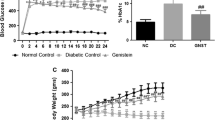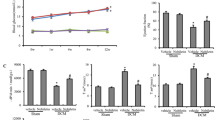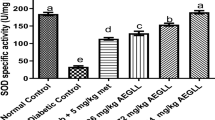Abstract
There is an increase in the incidence and prevalence of type-2 diabetes and obesity which leads to the structural and functional changes in myocardium leading to a lethal complication called diabetic cardiomyopathy (DCM). In the present study, we investigated the preventive effect of cinnamon (3% of Cinnamomum zeylanicum bark powder in AIN-93 diet for 3 months) feeding on DCM and the concerned mechanisms in a rodent model. Experimental diabetes was induced by a single intraperitoneal injection of 40 mg/kg b.w streptozotocin (STZ), 15 min after the ip administration of 60 mg/kg b.w of nicotinamide (NA) in Wistar-NIN (WNIN) male rats. The oxidative stress parameters were investigated by assessing superoxide dismutase (SOD), glutathione-s-transferase (GST) enzyme activity, protein carbonyls and malondialdehyde (MDA) levels. The histopathology of myocardium was analyzed by H&E and Masson’s trichrome staining, and scanning electron microscopy. The changes in diabetic rat heart involved the altered left ventricular parietal pericardium, structural changes in myocardial cells, enhanced oxidative stress. Masson’s trichrome and H&E staining have shown increased fibrosis, and perinuclear vacuolization in NA-STZ induced diabetic rat myocardium. Cinnamon feeding prevented the oxidative stress and myocardial alterations in the heart of diabetic rats. Taken together, these results suggest that cinnamon can effectively prevent the metabolic and structural changes in NA-STZ induced diabetic cardiomyopathy.






Similar content being viewed by others
Abbreviations
- T1D:
-
Type-1 diabetes
- T2D:
-
Type-2 diabetes
- DCM:
-
Diabetic cardiomyopathy
- AGEs:
-
Advanced glycation end products
- STZ:
-
Streptozotocin
- NA:
-
Nicotinamide
- VEGF:
-
Vascular endothelial growth factor
- SOD:
-
Superoxide dismutase
- GST:
-
Glutathione-s-transferase
References
IDF (2019) International Diabetes Federation DIABETES ATLAS 9th edition; 2019.
Einarson TR, Acs A, Ludwig C, Panton UH. Prevalence of cardiovascular disease in type 2 diabetes: a systematic literature review of scientific evidence from across the world in 2007–2017. Cardiovasc Diabetol. 2018;17(1):83.
Strain WD, Paldanius PM. Diabetes, cardiovascular disease and the microcirculation. Cardiovasc Diabetol. 2018;17(1):57.
Andersen AR, Christiansen JS, Andersen JK, Kreiner S, Deckert T. Diabetic nephropathy in Type 1 (insulin-dependent) diabetes: an epidemiological study. Diabetologia. 1983;25(6):496–501.
Barnes JA, Eid MA, Creager MA, Goodney PP. Epidemiology and Risk of Amputation in Patients With Diabetes Mellitus and Peripheral Artery Disease. Arterioscler Thromb Vasc Biol. 2020;40(8):1808–17.
Stegenga ME, et al. Hyperglycemia stimulates coagulation, whereas hyperinsulinemia impairs fibrinolysis in healthy humans. Diabetes. 2006;55(6):1807–12.
Dal Canto E, et al. Diabetes as a cardiovascular risk factor: An overview of global trends of macro and micro vascular complications. Eur J Prev Cardiol. 2019;26(2_suppl):25–32.
Movahed MR, Hashemzadeh M, Jamal MM. Diabetes mellitus is a strong, independent risk for atrial fibrillation and flutter in addition to other cardiovascular disease. Int J Cardiol. 2005;105(3):315–8.
Patel HP, Gandhi A, Trivedi S, Patel S. Prevalence and risk factors of cardiac autonomic neuropathy in diabetes mellitus. J Assoc Phys India. 2020;68(5):54.
Pinti MV, et al. Mitochondrial dysfunction in type 2 diabetes mellitus: an organ-based analysis. Am J Physiol Endocrinol Metab. 2019;316(2):E268–85.
Modesti A, et al. Hyperglycemia activates JAK2 signaling pathway in human failing myocytes via angiotensin II-mediated oxidative stress. Diabetes. 2005;54(2):394–401.
Yu W, et al. Curcumin alleviates diabetic cardiomyopathy in experimental diabetic rats. PloS One. 2012;7(12):e52013.
Ceylan-Isik AF, et al. Cardiac overexpression of metallothionein rescues cardiac contractile dysfunction and endoplasmic reticulum stress but not autophagy in sepsis. J Mol Cell Cardiol. 2010;48(2):367–78.
Zhang C, Yu H, Yang H, Liu B. Activation of PI3K/PKB/GSK-3beta signaling by sciadopitysin protects cardiomyocytes against high glucose-induced oxidative stress and apoptosis. J Biochem Mol Toxicol. 2021;e22887.
Kowluru RA, et al. Beneficial effects of the nutritional supplements on the development of diabetic retinopathy. Nutr Metab. 2014;11(1):8.
Kommula SR, et al. Cinnamon attenuated long-term IGT-induced retinal abnormalities via regulation of glucose homeostasis in neonatal streptozotocin induced rat model. Indian J Clin Biochem. 2020;35(4):442–50.
Saraswat M, et al. Antiglycating potential of Zingiber officinalis and delay of diabetic cataract in rats. Mol Vis. 2010;16:1525–37.
Muthenna P, et al. Inhibition of protein glycation by procyanidin-B2 enriched fraction of cinnamon: delay of diabetic cataract in rats. IUBMB Life. 2013;65(11):941–50.
Pradeep SR, Barman S, Srinivasan K. Attenuation of diabetic nephropathy by dietary fenugreek (Trigonella foenum-graecum) seeds and onion (Allium cepa) via suppression of glucose transporters and renin-angiotensin system. Nutrition. 2019;67–68:110543.
Hasanzade F, Toliat M, Emami SA, Emamimoghaadam Z. The effect of cinnamon on glucose of type II diabetes patients. J Tradit Complement Med. 2013;3(3):171–4.
Vafa M, et al. Effects of cinnamon consumption on glycemic status, lipid profile and body composition in type 2 diabetic patients. Int J Prev Med. 2012;3(8):531–6.
Mahdavi A, Bagherniya M, Mirenayat MS, Atkin SL, Sahebkar A. Medicinal plants and phytochemicals regulating insulin resistance and glucose homeostasis in type 2 diabetic patients: a clinical review. Adv Exp Med Biol. 2021;1308:161–83.
Ardalani H, Hejazi Amiri F, Hadipanah A, Kongstad KT. Potential antidiabetic phytochemicals in plant roots: a review of in vivo studies. J Diabetes Metab Disord. 2021.
Kooti W, Farokhipour M, Asadzadeh Z, Ashtary-Larky D, Asadi-Samani M. The role of medicinal plants in the treatment of diabetes: a systematic review. Electron Phys. 2016;8(1):1832–42.
Ziegenfuss TN, Hofheins JE, Mendel RW, Landis J, Anderson RA. Effects of a water-soluble cinnamon extract on body composition and features of the metabolic syndrome in pre-diabetic men and women. J Int Soc Sports Nutr. 2006;3:45–53.
Nyadjeu P, et al. Acute and chronic antihypertensive effects of Cinnamomum zeylanicum stem bark methanol extract in L-NAME-induced hypertensive rats. BMC Complement Altern Med. 2013;13:27.
Mohamed Sham Shihabudeen H, Hansi Priscilla D, Thirumurugan K. Cinnamon extract inhibits alpha-glucosidase activity and dampens postprandial glucose excursion in diabetic rats. Nutr Metab. 2011;8(1):46.
Saraswat M, Reddy PY, Muthenna P, Reddy GB. Prevention of non-enzymic glycation of proteins by dietary agents: prospects for alleviating diabetic complications. Br J Nutr. 2009;101(11):1714–21.
Muthenna P, Raghu G, Kumar PA, Surekha MV, Reddy GB. Effect of cinnamon and its procyanidin-B2 enriched fraction on diabetic nephropathy in rats. Chem Biol Interact. 2014;222:68–76.
Okuda J, Miwa I, Maeda K, Tokui K. Rapid and sensitive, colorimetric determination of the anomers of D-glucose with D-glucose oxidase, peroxidase, and mutarotase. Carbohydr Res. 1977;58(2):267–70.
Morgan Al CR. Immunoassay of insulin: two antibody system: plasma insulin levels of normal. Subdiabetic Diabetic Rats Diabetes. 1963;12(2):115–26.
Marklund S, Marklund G. Involvement of the superoxide anion radical in the autoxidation of pyrogallol and a convenient assay for superoxide dismutase. Eur J Biochem. 1974;47(3):469–74.
Habig WH, Pabst MJ, Jakoby WB. Glutathione S-transferases. The first enzymatic step in mercapturic acid formation. J Biol Chem. 1974;249(22):7130–9.
Uchida K, et al. Protein-bound acrolein: potential markers for oxidative stress. Proc Natl Acad Sci U S A. 1998;95(9):4882–7.
Bhuyan KC, Bhuyan DK, Podos SM. Lipid peroxidation in cataract of the human. Life Sci. 1986;38(16):1463–71.
Nimgulkar C, et al. Combination of spices and herbal extract restores macrophage foam cell migration and abrogates the athero-inflammatory signalling cascade of atherogenesis. Vascul Pharmacol. 2015;72:53–63.
Ranasinghe P, et al. Cinnamomum zeylanicum (Ceylon cinnamon) as a potential pharmaceutical agent for type-2 diabetes mellitus: study protocol for a randomized controlled trial. Trials. 2017;18(1):446.
Ranasinghe P, et al. Effects of Cinnamomum zeylanicum (Ceylon cinnamon) on blood glucose and lipids in a diabetic and healthy rat model. Pharmacogn Res. 2012;4(2):73–9.
Sharma S, Mandal A, Kant R, Jachak S, Jagzape M. Is cinnamon efficacious for glycaemic control in type-2 diabetes mellitus? J Pak Med Assoc. 2020;70(11):2065–9.
AlizadehBehbahani B, Falah F, Lavi Arab F, Vasiee M, TabatabaeeYazdi F. Chemical Composition and Antioxidant, Antimicrobial, and Antiproliferative Activities of Cinnamomum zeylanicum Bark Essential Oil. Evid Based Complement Alternat Med. 2020;2020:5190603.
Meena Vangalapati NSS, Surya Prakash DV, Sumanjali A. A Review on Pharmacological Activities and Clinical effects of Cinnamon Species. Res J Pharm Biol Chem Sci. 2012;3(1).
Abdelmageed ME, Shehatou GS, Abdelsalam RA, Suddek GM, Salem HA. Cinnamaldehyde ameliorates STZ-induced rat diabetes through modulation of IRS1/PI3K/AKT2 pathway and AGEs/RAGE interaction. Naunyn Schmiedebergs Arch Pharmacol. 2019;392(2):243–58.
Hosni AA, Abdel-Moneim AA, Abdel-Reheim ES, Mohamed SM, Helmy H. Cinnamaldehyde potentially attenuates gestational hyperglycemia in rats through modulation of PPARgamma, proinflammatory cytokines and oxidative stress. Biomed Pharmacother. 2017;88:52–60.
Singh P, et al. Potential Dual Role of Eugenol in Inhibiting Advanced Glycation End Products in Diabetes: Proteomic and Mechanistic Insights. Sci Rep. 2016;6:18798.
Faam MT, Sarmidi MR. A proanthocyanidin from cinnamomum zeylanicum stimulates phosphorylation of insulin receptor in 3T3–L1 adipocytes. J Teknol. 2006;44(1):53–68.
Frangogiannis NG. Cardiac fibrosis: Cell biological mechanisms, molecular pathways and therapeutic opportunities. Mol Aspects Med. 2019;65:70–99.
Shimizu M, et al. Collagen remodelling in myocardia of patients with diabetes. J Clin Pathol. 1993;46(1):32–6.
Niknezhad F, et al. Improvement in histology, enzymatic activity, and redox state of the liver following administration of Cinnamomum zeylanicum bark oil in rats with established hepatotoxicity. Anat Cell Biol. 2019;52(3):302–11.
Manrique Franco K, Aragon Valera C, Gutierrez Medina S, Sanchez-Vilar Burdiel O, RoviraLoscos A. Acute pericarditis associated to onset of diabetes mellitus. Endocrinol Nutr. 2012;59(10):608–9.
Shen X, Zheng S, Metreveli NS, Epstein PN. Protection of cardiac mitochondria by overexpression of MnSOD reduces diabetic cardiomyopathy. Diabetes. 2006;55(3):798–805.
Im K, et al. Effects of the polyphenol content on the anti-diabetic activity of Cinnamomum zeylanicum extracts. Food Funct. 2014;5(9):2208–20.
Li R, et al. Protective effect of cinnamon polyphenols against STZ-diabetic mice fed high-sugar, high-fat diet and its underlying mechanism. Food Chem Toxicol. 2013;51:419–25.
Han B, Baliga R, Huang H, Giannone PJ, Bauer JA. Decreased cardiac expression of vascular endothelial growth factor and redox imbalance in murine diabetic cardiomyopathy. Am J Physiol Heart Circ Physiol. 2009;297(2):H829-835.
Acknowledgements
This work was supported by grants from Department of Biotechnology, Government of India to PS and GBR. CUK was supported by a research fellowship from the Indian Council of Medical Research, Government of India. We thank Khaja Ather Hussain for histological analysis and also Mr. Manohar Reddy for statistical analysis.
Funding
This work was supported by grants from Department of Biotechnology, Government of India to PS and GBR. CUK was supported by a research fellowship from the Indian Council of Medical Research, Government of India.
Author information
Authors and Affiliations
Corresponding author
Ethics declarations
We affirm that our work is original and is not submitted to any other journal except as an abstract in conferences. All authors have read and approved the manuscript and are aware of its submission.
Ethics approval
Obtained ICMR-National Institute of Nutrition Institutional Animal Ethical Clearance.
Conflicts of interest/Competing interests
No conflict of interest.
Additional information
Publisher’s note
Springer Nature remains neutral with regard to jurisdictional claims in published maps and institutional affiliations.
Rights and permissions
About this article
Cite this article
Kumar, C.U., Reddy, S.S., Suryanarayana, P. et al. Protective effect of cinnamon on diabetic cardiomyopathy in nicotinamide-streptozotocin induced diabetic rat model. J Diabetes Metab Disord 21, 141–150 (2022). https://doi.org/10.1007/s40200-021-00948-3
Received:
Accepted:
Published:
Issue Date:
DOI: https://doi.org/10.1007/s40200-021-00948-3




